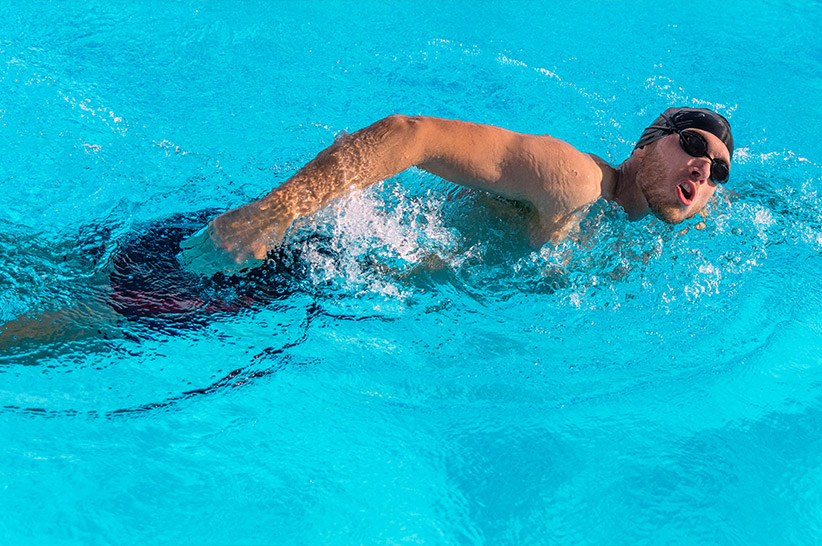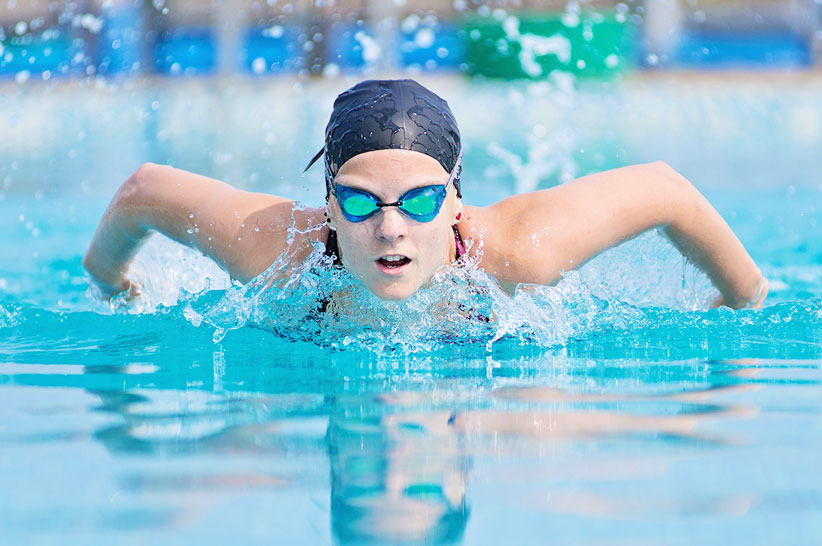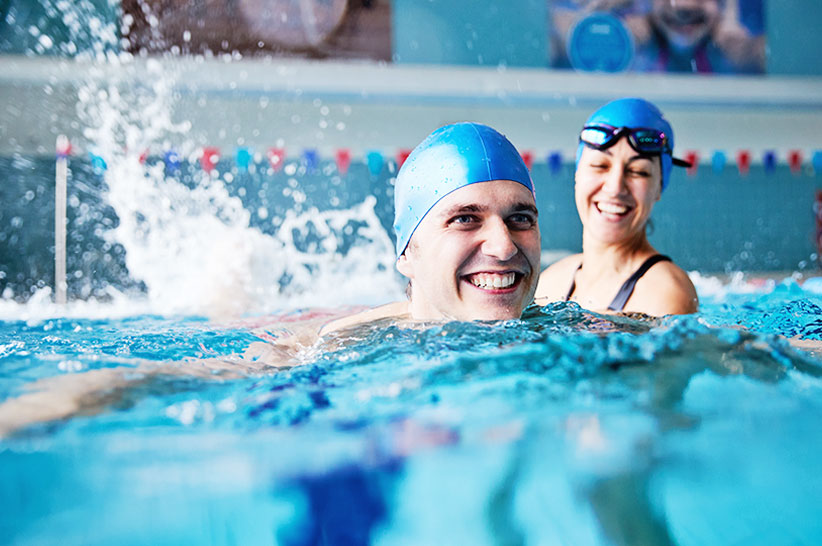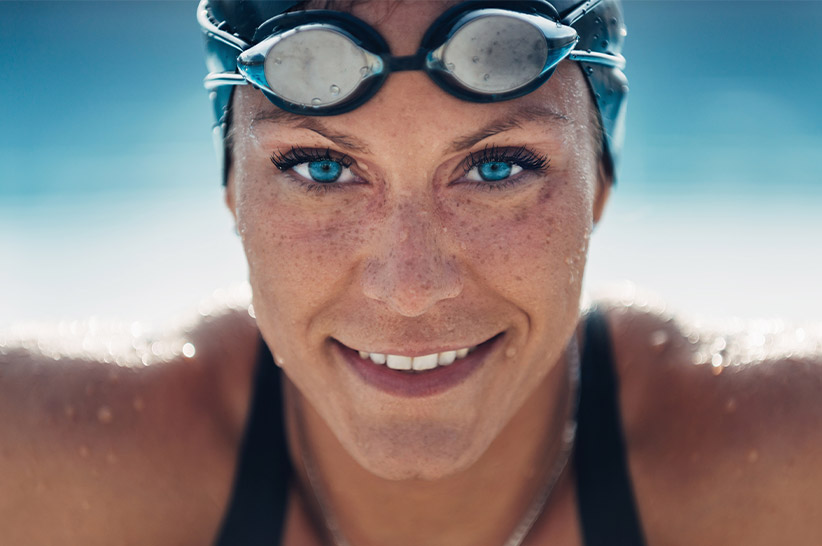A lot of people are under the impression that you can’t lose weight with swimming because it doesn’t require the same amount of physical pressure as other land-based exercises.
However, that’s not true, and our swimming for weight loss tips will show you how to achieve your goal weight correctly.
Is Swimming a Good Way to Lose Weight?
Yes, you can lose a substantial amount of weight with swimming if you do it correctly. How much weight you can lose depends on several things like your current weight, height, age, swimming duration, and swimming styles. In general, heavier individuals may lose weight faster due to their higher metabolism and calorie needs. It also depends on other factors such as your diet and health condition. You’re not going to lose weight if you swim and overeat or eat back the calories burned from swimming.
According to Tom Holland, a sports nutritionist and an exercise physiologist, a 150 lb person can burn up to 400 calories during an hour of swimming at a moderate pace and up to 700 calories at a vigorous pace. You need to burn 3500 calories to get rid of one pound of fat 1.
If you swim for 180 minutes per week (60-minute sessions) and burn 500 calories per session, you’ll eliminate 1500 of those 3500 calories. This means you only have to take away 300 calories per day from your diet to lose one pound per week.
One study examined the effectiveness of swimming on body composition, physical strength, and cholesterol profiles in 24 middle-aged women. The women were assigned to either a swimming group or a control group. The swimming group practiced 60-minute sessions of swimming three times per week for 12 weeks. Results showed more significant weight reduction and cardiovascular endurance in the swimming group 2.
The above is just an average estimate of how much weight or how fast you can expect to lose weight with swimming. You may be able to lose more weight if you combine it with some of the tips we’ve discussed below.
Three to four times per week is sufficient to lose weight with swimming when combined with a healthy diet. As stated above, you can expect to lose 400-700 calories per 60-minute session of swimming.
Here are some reasons why swimming is a great exercise for weight loss and health:
Overall body workout
Swimming requires the use of every muscle in your body so each kick, push, and pull will be a useful muscle strengthening exercise.
Easy on the joints
Some people avoid exercise because of the pressure it may put on their joints and swimming can eliminate that. Swimming also has fewer risks of physical injuries compared to other land-based activities such as strength training or running.
In fact, many athletes include swimming in their fitness program. Professional beach volleyball athlete Amanda Dowdy tweets about swimming as her favorite low-impact workout:
Gooood morning! One of my fave ways to recover from travel, competition, or a hard workout is a pool workout. It feels so good to take the impact off my joints, get my ❤️ rate up & move my body!! Get in the pool & try it out! #poolworkout #TuesdayMotivation #trainrecoverrepeat pic.twitter.com/0qXFiAW2uw
— Amanda Dowdy Lawson (@Amanda_Dowdy) May 22, 2018
An enjoyable way to burn calories
Swimming is a therapeutic and enjoyable exercise. A lot of people see swimming as a recreational activity than a workout so it can become easier to incorporate into your life in the long run.
May improve cardiovascular health
One study investigated the effectiveness of high-intensity intermittent swimming on cardiovascular health in 62 women with hypertension. Results showed a reduction in blood pressure and fat mass, both of which are known contributing factors of cardiovascular health 3.
Improved general well-being
A 2004 study found that winter swimming helped improve the overall wellbeing of the swimmers. Some of the improvements in their health included relief from tension, memory, fatigue, asthma, and body pain 4.
10 Tips to Maximize Swimming for Weight Loss

Photo by Shutterstock.com
1. Create a regimen
Plan how many days you can swim each week and swim for at least an hour for each session. Three-four times per week is a good start to lose weight. You may also want to stick a printed copy of it somewhere in your bedroom to keep as a daily reminder.
2. Gradually increase swim time
If you’re new or still a beginner to swimming, start slowly and then gradually increase your swim time. For example, you could swim for 30-60 seconds and then rest for 30-60 seconds. Repeat this for 30-60 minutes in the first week. You can increase your swim time, the number of laps, swim styles and, duration every week.
3. Combine HIIT
High-intensity interval training (HIIT) can help you lose weight faster, and it’s easy to combine it into any form of exercise. In short, it’s when you practice a form of physical activity in this format: few minutes of high-speed + few minutes of slow-speed + repetition.
One study examined the effectiveness of HIIT in 250 overweight/obese adults over 12 months. Results showed that those who completed the unsupervised HIIT program had more significant weight reduction and visceral (belly) fat loss 5.
Go for a swimming sprint by swimming at a fast pace for one lap and then at your average pace for another lap. Repeat this 5-10 times. You could also try swimming at your maximum speed for one minute and then slow down for one minute. Repeat this cycle 5-10 times.
Once you become an advanced swimmer, you could increase the time or number of laps you swim at high-speed. For example, you can swim at your maximum pace for 3-4 laps and then swim one lap slowly.
Some HIIT exercises can even be performed in a pool!
4. Try different strokes
Freestyle is considered to be the best swim stroke to burn calories without getting too exhausted. A 150 lbs person can expect to burn 700 calories per hour swimming freestyle. Some strokes can help you burn more calories than others, and you may also find it enjoyable to experiment with new swimming techniques.
For example, a 5”3 female who weighs 175 lbs can expect to burn 655 calories per hour using the butterfly stroke, and 604 calories using the backstroke 6.

Photo by Shutterstock.com
Vary your swimming techniques using different strokes such as butterfly stroke, backstroke, and breaststroke. You could also experiment with some kick in exercises to burn more calories and tone your muscles.
You don’t have to do this right away, and it’s certainly not a must. The best swim stroke is the one you perform best.
5. Suppress swimmer’s appetite
Swimmers tend to feel more hungry after swimming compared to those who practice land-based exercises such as walking and jogging. Some sources say the reason why swimmers feel the need to eat something warm right after swimming is because of the cooling effect of the water temperature on their body.
You can combat this by bringing your own portioned meal from home or any small healthy snacks such as fruits and nuts. If you forgot to bring something healthy to eat and you find yourself tempted to buy fast food items like burger, go for it but without the bun. Buy a salad instead of fries and sparkling water or a low-carb smoothie instead of coke.
Making small changes like the above can make a big difference in your weight loss journey.
6. Create a caloric deficit
You will lose weight when you ingest fewer calories than your body needs. For example, if you currently consume 2000 calories per day, you will lose weight when you take out 500 calories per day.
Using a weight loss calculator can help you figure out exactly how many calories you’ll need to eat per day to reach your weight loss goals. A restricted calorie diet combined with regular exercise such as swimming is an ultimate way to lose weight faster.
Avoid reducing your calorie intake drastically in hopes to lose weight faster as it may make you feel weak and increase your cravings. Taking away 500-800 from your daily calories is enough to lose weight.
7. Go to swimming lessons or hire a coach
Go to swimming lessons or hire a coach to help you become a better swimmer and to learn advanced techniques. This will make it easier to learn how to control your breathing and how to swim at ease. You’ll also be able to learn a variety of stroke styles faster.

8. Ask a friend to join you
Never underestimate the power of having a support system when it comes to losing weight. Having a friend or someone to join you in swimming or at least to go with you can help motivate you.
You can also join swimming forums and download a weight loss app to connect with like-minded individuals. One study found that a friend, coworker, and family support for healthy lifestyle changes predicted improved weight management in adult employees 7.
9. Reduce sugar intake
Sugar contributes to weight gain, especially in the abdominal region 8. Lowering or eliminating sugar from your diet is one way to speed up your weight loss with swimming. Consider making your low carb desserts and snacks and keeping them in small portions if you think you’ll find it harder to give up sugar.
10. Meal prep
Meal prepping can help you avoid overeating and eating the wrong types of foods. It can also be useful if you’re a busy person who doesn’t always have the time to cook each meal. There are so many helpful YouTube videos where you can learn how to meal prep correctly. Another benefit of meal prepping is that you’ll get the right amount of each of your macronutrients (protein, carbs, and fat) in your meals.
A 2017 study assessed the effectiveness of meal planning on food variety, diet quality, and weight status in 40,554 french adults. Results revealed that meal planning was associated with a healthier diet and less obesity 9.
Conclusion
Swimming is an enjoyable and efficient way to lose weight. Combining it with a restricted calorie diet and high-intensity interval training (HIIT) can help you lose weight faster.
Takeaways
- You’ll need to burn 3500 calories to lose one pound of fat. A 150 lb person can burn 400-700 calories per 60-minute session of swimming.
- You need to burn more calories than you ingest to lose weight. Thus taking away 500-800 from your current daily calories (combined with swimming) will help speed up your weight loss with swimming.
- Be aware of the swimmer’s appetite and bring small healthy meals or snacks to eat after swimming.










![Juicing for Weight Loss: Everything You Need to Know [Plus Recipes]](/wp-content/uploads/2019/08/Juicing-for-Weight-featured-image.jpg)










